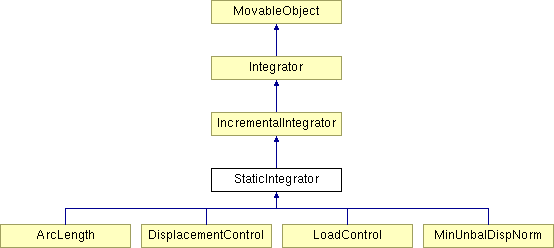Main Page Class Hierarchy Alphabetical List Compound List File List Compound Members File Members
StaticIntegrator Class Reference#include <StaticIntegrator.h>
Inheritance diagram for StaticIntegrator::
 List of all members.
List of all members.
Detailed Description
StaticIntegrator is an abstract class. It is a subclass of IncrementalIntegrator provided to implement the common methods among integrator classes used in performing a static analysis on the FE\_Model. The StaticIntegrator class provides an implementation of the methods to form the FE\_Element and DOF\_Group contributions to the tangent and residual. A pure virtual method {newStep()} is also defined in the interface, this is the method first called at each iteration in a static analysis, see the StaticAnalysis class. \
In static nonlinear finite element problems we seek a solution ( ,
,  ) to the nonlinear vector function
) to the nonlinear vector function
\begin{equation} \R(U, \lambda) = \lambda \P - \F_R(U) = \zero \label{staticGenForm} \end{equation}
The most widely used technique for solving the non-linear finite element equation, equation~\ref{femGenForm}, is to use an incremental scheme. In the incremental formulation, a solution to the equation is sought at successive incremental steps.
\begin{equation} \R(U_{n}, \lambda_n) = \lambda_n \P - \F_R(U_{n}) \label{staticIncForm} \end{equation}
The solution of this equation is typically obtained using an iterative procedure, in which a sequence of approximations ( ,
,  ),
),  is obtained which converges to the solution (
is obtained which converges to the solution ( ,
,  . The most frequently used iterative schemes, such as Newton-Raphson, modified Newton, and quasi Newton schemes, are based on a Taylor expansion of equation~\ref{staticIncForm} about (
. The most frequently used iterative schemes, such as Newton-Raphson, modified Newton, and quasi Newton schemes, are based on a Taylor expansion of equation~\ref{staticIncForm} about ( ,
,  ):
):
\begin{equation} \R(U_{n},\lambda_n) = \lambda_n^{(i)} \P
- \f_{R}\left(U_{n}^{(i)} \right) - \left[ \begin{array}{cc} K_n^{(i)} & -\P \ \end{array} \right] \left\{ \begin{array}{c} U_{n} - U_{n}^{(i)} \ \lambda_n - \lambda_n^{(i)} \end{array} \right\} \label{staticFormTaylor} \end{equation}
which a system of of  equations with (
equations with ( ) unknowns. Two solve this, an additional equation is required, the constraint equation. The constraint equation used depends on the static integration scheme, of which there are a number, for example load control, arc length, and displacement control. \
) unknowns. Two solve this, an additional equation is required, the constraint equation. The constraint equation used depends on the static integration scheme, of which there are a number, for example load control, arc length, and displacement control. \
Definition at line 109 of file StaticIntegrator.h.
Constructor & Destructor Documentation
|
StaticIntegrator::StaticIntegrator (
|
int classTag )
|
|
|
StaticIntegrator::~StaticIntegrator (
|
) [virtual]
|
|
|
|
Does nothing. Provided so that the subclasses destructors will be called.
Definition at line 54 of file StaticIntegrator.cpp. |
Member Function Documentation
|
int StaticIntegrator::formEleResidual (
|
FE_Element * theEle ) [virtual]
|
|
|
|
To form the residual vector of the FE\_Element, {theEle}, is instructed to zero the vector and then add it's  vector to the residual, i.e. it performs the following: \begin{tabbing} while \= \+ while \= while \= \kill theEle-
vector to the residual, i.e. it performs the following: \begin{tabbing} while \= \+ while \= while \= \kill theEle- zeroResidual()
zeroResidual()
Reimplemented from IncrementalIntegrator.
Definition at line 78 of file StaticIntegrator.cpp. |
|
int StaticIntegrator::formEleTangent (
|
FE_Element * theEle ) [virtual]
|
|
|
int StaticIntegrator::formNodTangent (
|
DOF_Group * theDof ) [virtual]
|
|
|
int StaticIntegrator::formNodUnbalance (
|
DOF_Group * theDof ) [virtual]
|
|
|
|
To form the unbalance vector of the DOF\_Group, {theDof}, is instructed to zero the vector and then add it's  vector to the unbalance, i.e. it performs the following: \begin{tabbing} while \= \+ while \= while \= \kill theDof-
vector to the unbalance, i.e. it performs the following: \begin{tabbing} while \= \+ while \= while \= \kill theDof- zeroUnbalance()
zeroUnbalance()
Reimplemented from IncrementalIntegrator.
Definition at line 96 of file StaticIntegrator.cpp. |
|
int StaticIntegrator::newStep (
|
void ) [pure virtual]
|
|
The documentation for this class was generated from the following files:
|



